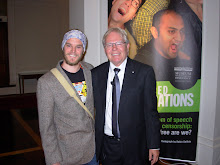After letting slip with my secret confession that I had not seen Alfred Hitchcock’s North by Northwest (1959) in a recent podcast, I thought it was high time I right this wrong. Here we go.
The film stars a classic Hollywood star Cary Grant, in a classic mistaken identity plot. The film starts out by perfectly evoking the rush and crush of city life. The Hitch cameo comes early, and it helps evoke this atmosphere as the director races for, but ultimately fails to catch, a bus. And it is in this environment that Grant’s Roger O. Thornhill thrives as a high powered advertising executive. He is soon dislocated from his domain though as he is mysteriously kidnapped by thugs who mistake him for someone else. The film eventually morphs into a transamerican chase film, at which point Grant is paired up with Eva Marie Saint who plays an interesting variation on the Hitchcock blonde. She is a complex love interest who mysteriously helps a fugitive for no real reason and is heavily involved in one of the film’s great twists. The whole film is driven by an absolutely cracking script which manages to be funny, mysterious and clever. The director harnesses the script to put us in the protagonist’s shoes, and just as he has little idea what is unfolding, we too are left in the dark. The effect is that the film builds a wonderful sense of mystery as we the audience, and Thornhill, try to establish exactly who his kidnappers are, and what they want with him.Hitchcock’s penchant for clever shots that make film nerds everywhere swoon is also on display throughout the film. As Thornhill flees following the murder at the U.N, Hitch delivers what is surely one of the great high angle shots of all time. It is shot from a towering, dizzying height as Grant’s character races out of the building through a courtyard. There is also a cracker of a POV shot towards the end of the film which makes the audience cop a punch to the head. The script also delivers some rather forward dialogue, dripping with flirting and sexual innuendo. This film features probably the dirtiest conversation ever held on a train. The conclusion of the film wraps up incredibly quickly, as mentioned by Jon in the podcast. Actually it is unfathomably quick; I had to re-watch it just to establish what had happened. The last 10 or so minutes of the film features twist upon twist, most of which are satisfying ones.
I coined the rather silly title for this piece before I actually watched the film. I thought of it because for some reason, I thought this was going to be a more light-hearted film from Hitchcock. And whilst it is a little slighter than some of his films, it is definitely not a defining marker of the movie. Even so, I think the title is still apt because the film is highlighted by a number of massive set-pieces in which the director is clearly having a lot of fun, revelling in being delightfully over the top. The first of these comes early in the film, where an attempt to take Thornhill’s life results in his car dangling over a cliff, which is followed by a drunken car chase. This sort of sums up Hitch’s brilliance in this film. A car chase is a stock element, but he reimagines it, making it slow paced as Thornhill tries to overcome his inebriation to escape. And Cary Grant makes a fantastic drunk. Hitch follows this pattern with set piece after set piece: the murder at the U.N, the fantastic finale atop Mount Rushmore and of course the piece de resistance of set pieces – the crop duster scene. This sequence is magnificently constructed with shots of the empty countryside increasing the sense of isolation, and car after car raising Thornhill’s hopes that the man he is waiting for will arrive. Despite not being exactly logical, surely there are easier ways to kill a man than with a crop duster, the scene is ultra exciting. And eat your heart out Michael Bay, it ends with a frickin plane flying into a frickin petrol tanker. Drawing attention to the fact that the film is essentially a few big set pieces linked together, would be a criticism of most films. But the great thing about all of these set pieces is that they are reimagined brilliantly in a way that you suspect only Hitchcock could pull off. They are just all so good. Speaking of the director’s ability for reimagination and originality, the whole film is a genre flick, a spy thriller, as reimagined by Hitch. A spy thriller full of government espionage that simply does not focus on the spy at all, rather examining the outer reaches of the web and the everyman caught up in it.
This is a wonderful romp which features one of the absolute best scripts of all time. Like every Hitchcock film there is so much here worth seeing, he truly is a master director and there has never been another like him. Do I prefer it to Rear Window (1954)? Not quite, but it is a very different film and both are true classics.
Verdict: Pint of Kilkenny
Progress: 43/1001

No comments:
Post a Comment